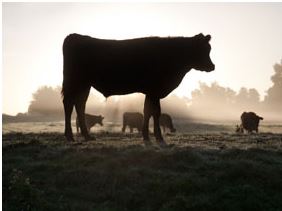



Feed Efficiency Research to Improve Beef Industry's Bottom Line
Feedlot data shows improvements in feed efficiency have been slow in recent decades which has prompted Canadian scientists to look into the weight gain genetics of eight breeds.One of those researchers is Dr. Bob Weaber of Kansas State University.
Dr Weaber and his colleagues are in the middle of a five year, $5 million project that includes 24 seedstock producers and a commercial feedlot, says Genome Alberta.
Two-thirds of the project covers research and the other third is dedicated to extension.

Researchers are pulling DNA samples from 10,000 cattle representing eight beef breeds, including Angus, Red Angus, Simmental, Gelbvieh, Charolais, Hereford, Wagyu and Limousin.
Weaber told delegates at the 2012 International Committee for Animal Recording in Ireland that he and his colleagues are trying to identify markers that work across breeds, when possible.
“And certainly one of the things we’re trying to do is understand a bit more the interaction between diet–energy density, specifically–and genotype.”
They’re also studying microbial populations, genes affecting metabolism, differences linked to mitochondrial and nuclear genomes, and analyzing high and low RFI cattle in detail.
Why feed efficiency matters
The beef industry has a very good reason to improve feed efficiency – it takes a big bite out of everyone’s wallets. Weaber said in the U.S. beef industry, feed efficiency costs have swallowed between 50 to 70 per cent of production costs.
“And certainly over the last few years with the dramatic changes in our grain prices in the United States, we would probably exceed the 70 per cent mark,” he said. A 10 per cent improvement in feed efficiency in feedlots would cut feed costs by $1.2 billion, based on 2011 numbers, he said.
“A huge, huge number. And it doesn’t take a lot of rocket science to say, ‘Okay, we’ve got a $5 million project at play. The potential return on that investment is pretty dramatic.’”
Weaber breaks feed efficiency down into two processes. More feed efficient livestock may be able to digest or absorb nutrients more efficiently. They could also be more metabolically efficient, meaning they use absorbed nutrients more efficiently.
Data from feedlots show very slow gains in feed efficiency over the years.
“We have a tendency in our country–and I suspect producers in other countries struggle with this–we get very focused on particularly output traits in our system because they’re typically pretty easy to measure. Things like weaning weight, yearling weight, carcass weight, other carcass parameters,” said Weaber.
“That’s fine, but we need to start to do a better job documenting the cost side of our production systems.”
For example, Weaber said about half the calories consumed in the U.S. beef production system go to cow herd maintenance. “So the amount of nutrients that actual go to producing saleable product is only about 20 per cent of the calories.”
But nailing down the appropriate phenotypic trait to use to improve genetics is a challenge, Weaber said. “We’ve seen over time the consequences of selection for either feed to gain (ratio) or average daily gain typically results in larger mature sizes and leaner body types.”
Residual feed intake (RFI) tries to correct those problems. “It corrects for differences in gain and metabolic body weight to try and get more of a clean and pure measure of efficiency.”
But RFI data is collected at various growth stages and from cattle with various body compositions. And from the animal breeding side, “since it is a statistic residual, all of the errors in the model that we’re looking at land in the piece of data we’re trying to use for selection. And I don’t know about the rest of you, but that seems problematic to me.”
Beef Innovations 2013 is slated for July 15th and 16th in Calgary.



